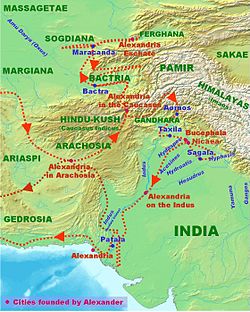Indian campaign of Alexander the Great
| Alexander's Indian campaign | |||||||
|---|---|---|---|---|---|---|---|
| Part of the Wars of Alexander the Great | |||||||
 Campaigns and landmarks of Alexander's invasion of India |
|||||||
|
|||||||
| Belligerents | |||||||
| Macedonia | various | ||||||
| Commanders and leaders | |||||||
| Alexander the Great | various | ||||||
The Indian campaign of Alexander the Great began in 326 BC. After conquering the Achaemenid Empire of Persia, the Macedonian king (and now the great king of the Persian Empire) Alexander launched a campaign into India. The Battle of the Jhelum river against a regional Indian King, Porus is considered by many historians, Peter Connolly being one of them, as the most costly battle that the armies of Alexander fought.
The rationale for this campaign is usually said to be Alexander's desire to conquer the entire known world, which the Greeks thought ended in India. While considering the conquests of Carthage and Rome, Alexander died in Babylon on June 10 or 11, 323 BC. In 321 BC, two years after Alexander's death, Chandragupta Maurya of Magadha, founded the Maurya Empire in India.
After the death of Spitamenes and his marriage to Roxana (Raoxshna in Old Iranian) to cement his relations with his new Central Asian satrapies, in 326 BC Alexander was finally free to turn his attention to India.
Alexander invited all the Chieftains of the former satrapy of Gandhara, to come to him and submit to his authority. Ambhi (Greek: Omphis), ruler of Taxila, whose kingdom extended from the Indus to the Jhelum (Greek: Hydaspes), complied. At the end of the spring of 327 BC, Alexander started on his Indian expedition leaving Amyntas behind with 3,500 horse and 10,000 foot soldiers to hold the land of the Bactrians.
...
Wikipedia
